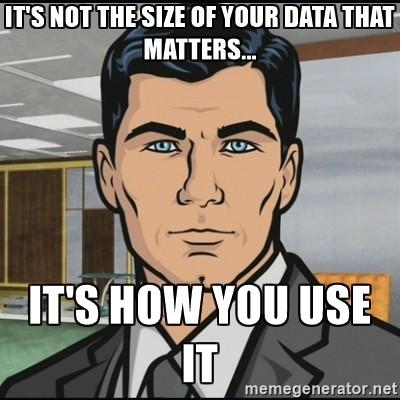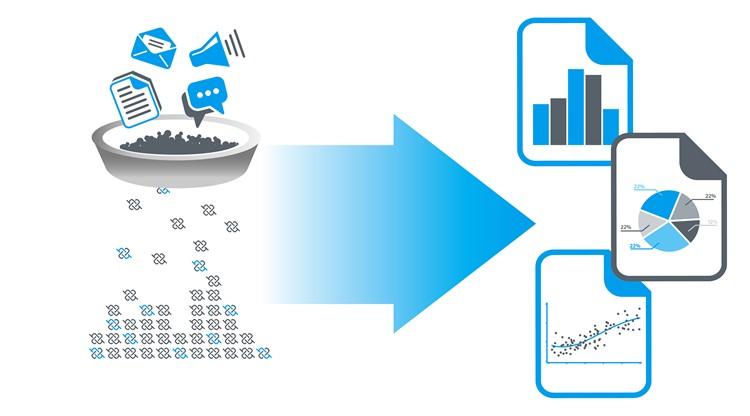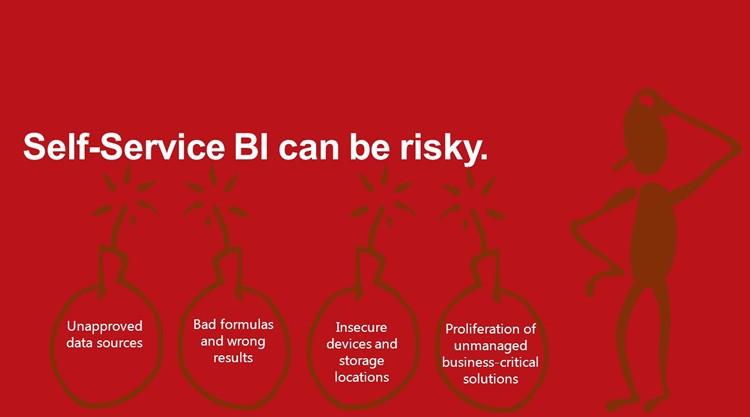
Top 10 Business Intelligence Predictions for 2026 and Beyond
This article was penned by Yellowfin CEO and Co-founder, Glen Rabie, and was first published under the title ‘The next wave in business intelligence’ on InsideBI.com.
When Harvard Business Review declared the data scientist was the “sexiest” job of the 21st century back in 2012, even they would have been surprised how mainstream data analysis and Business Intelligence (BI) has become.
The rise and rise of BI technology has been driven by, and facilitated, exciting changes in the way data is produced and used for competitive gain. Over the next 12 months the business analytics industry will be characterized by changing technology as vendors try to keep-up with new user types, BI use cases, usage models and data sources.
Perhaps most of all, the analytics fire is being fuelled by continued prioritization, with the 2016 version of Gartner’s global CIO Agenda Survey again naming BI and analytics as the number one technology priority for the year ahead.
So here are ten trends set to shape the BI landscape over the coming 12 months:
1. A convergence of capabilities
 The past 12 months has seen many technology providers in the business analytics space aggressively acquire other companies and develop additional products in an attempt to bridge gaps in their offerings. Why? Because vendors are responding to market demand that stipulates that organizations want to apply reporting and analytics to more use cases and provide access to more user types. Organizations no longer want one product to take care of their Data Discovery needs, and another for enterprise reporting. They want one BI platform that supports multiple BI use cases and user types.
2. Governed Data Discovery
The past 12 months has seen many technology providers in the business analytics space aggressively acquire other companies and develop additional products in an attempt to bridge gaps in their offerings. Why? Because vendors are responding to market demand that stipulates that organizations want to apply reporting and analytics to more use cases and provide access to more user types. Organizations no longer want one product to take care of their Data Discovery needs, and another for enterprise reporting. They want one BI platform that supports multiple BI use cases and user types.
2. Governed Data Discovery
 While many organizations were initially attracted to the concept of desktop driven Data Discovery capabilities – which theoretically put the power of data analysis in the hands of the individual, while bypassing bottlenecks created by traditional IT-centric BI – most are now grappling with major Excel-like governance issues. Therefore, the need to reinstate trust and reliability back into the analytics practices of organizations has never been higher. Enter Governed Data Discovery.
3. The death of self-service BI
While many organizations were initially attracted to the concept of desktop driven Data Discovery capabilities – which theoretically put the power of data analysis in the hands of the individual, while bypassing bottlenecks created by traditional IT-centric BI – most are now grappling with major Excel-like governance issues. Therefore, the need to reinstate trust and reliability back into the analytics practices of organizations has never been higher. Enter Governed Data Discovery.
3. The death of self-service BI
 The need to find greater balance in BI deployments – between the information access needs of business users and the governance requirements of IT – will kill the concept of self-service BI as it’s currently known. Demand will continue to quickly climb for a single trustworthy BI environment that simultaneously empowers business users to access, share and act on BI content, while providing IT the oversight required to ensure published content is accurate and always based on the same data.
4. Collaboration
The need to find greater balance in BI deployments – between the information access needs of business users and the governance requirements of IT – will kill the concept of self-service BI as it’s currently known. Demand will continue to quickly climb for a single trustworthy BI environment that simultaneously empowers business users to access, share and act on BI content, while providing IT the oversight required to ensure published content is accurate and always based on the same data.
4. Collaboration
 As the need for greater collaboration between IT, business users and data analysts continues to be recognized – in order to deliver actionable and trustworthy BI insights, particularly on a large scale – demand for in-application mechanisms to support that collaboration will also grow. BI vendors will need to develop in-application workflows that empower business users to request new reports and fresh data-based insights, proactively working with the data experts in their organization to quickly deliver.
5. Data storytelling
As the need for greater collaboration between IT, business users and data analysts continues to be recognized – in order to deliver actionable and trustworthy BI insights, particularly on a large scale – demand for in-application mechanisms to support that collaboration will also grow. BI vendors will need to develop in-application workflows that empower business users to request new reports and fresh data-based insights, proactively working with the data experts in their organization to quickly deliver.
5. Data storytelling
 With more and more data becoming available for reporting and analytics, it’s important that people are able to present data as part of a coherent story. After all, effective data analysis is more than just data and charts. It’s about finding and telling a story. To communicate the implications of data analysis in a compelling manner, organizations will increasingly look to harness the power of data-driven storytelling capabilities to inspire action by connecting logic with emotion. Simply put, combing effective storytelling methods with data analysis can unlock the insights in data, help audiences understand the significance of their data, and thereby assist decision-makers to take smarter action and instigate positive change.
With more and more data becoming available for reporting and analytics, it’s important that people are able to present data as part of a coherent story. After all, effective data analysis is more than just data and charts. It’s about finding and telling a story. To communicate the implications of data analysis in a compelling manner, organizations will increasingly look to harness the power of data-driven storytelling capabilities to inspire action by connecting logic with emotion. Simply put, combing effective storytelling methods with data analysis can unlock the insights in data, help audiences understand the significance of their data, and thereby assist decision-makers to take smarter action and instigate positive change.
 Try It Free
6. Growth in Cloud BI
Try It Free
6. Growth in Cloud BI
 As BI capabilities become more commonplace, and the benefits of BI-driven decision-making become broadly accepted, organizations will look to rollout reporting and analytics capabilities more pervasively and at reduced costs. The flexibility offered by cloud-based deployments can reduce BI’s total cost of ownership significantly, which is evidenced by the climbing popularity of SaaS BI implementations.
7. Growth in cloud-based data sources
As BI capabilities become more commonplace, and the benefits of BI-driven decision-making become broadly accepted, organizations will look to rollout reporting and analytics capabilities more pervasively and at reduced costs. The flexibility offered by cloud-based deployments can reduce BI’s total cost of ownership significantly, which is evidenced by the climbing popularity of SaaS BI implementations.
7. Growth in cloud-based data sources
 While the growth in cloud-based applications and data sources is one of the driving forces behind the increase in SaaS BI deployments, it also intensifies the need for BI solutions to enable users to easily connect to, analyze and integrate that information into broader organizational reporting initiatives. BI vendors need to play an important role in facilitating swift analysis of data contained within popular cloud applications such as Twitter, YouTube, Google Sheets and Google Analytics.
8. Growth in Embedded BI and customized analytical applications
While the growth in cloud-based applications and data sources is one of the driving forces behind the increase in SaaS BI deployments, it also intensifies the need for BI solutions to enable users to easily connect to, analyze and integrate that information into broader organizational reporting initiatives. BI vendors need to play an important role in facilitating swift analysis of data contained within popular cloud applications such as Twitter, YouTube, Google Sheets and Google Analytics.
8. Growth in Embedded BI and customized analytical applications
 As the thirst for reporting and analytics capabilities grows, in both consumer and business environments, applications of all kinds will look to integrate BI functionality into their solutions. But, it won’t stop there. Both organizations directly using BI, and the application developers looking to add reporting and analytics capabilities to their software, will demand increasing levels of customization. This demand for customized analytics experiences is being driven by both a desire to align that analytics functionality with corporate styling, and to also make analytics more consumable for more target audiences.
9. The rise of the Internet of Things
As the thirst for reporting and analytics capabilities grows, in both consumer and business environments, applications of all kinds will look to integrate BI functionality into their solutions. But, it won’t stop there. Both organizations directly using BI, and the application developers looking to add reporting and analytics capabilities to their software, will demand increasing levels of customization. This demand for customized analytics experiences is being driven by both a desire to align that analytics functionality with corporate styling, and to also make analytics more consumable for more target audiences.
9. The rise of the Internet of Things
 IoT describes the phenomena of the emergence of ’smart’ devices, which are networked, via the Internet, and are capable of capturing and transmitting data independently of human-to-human or human-to-computer interaction. These smart, networked devices collect and receive vast amounts of data about aspects of our personal and professional lives. So, it’s not just the smart devices themselves that directly improve our lives, but more so the potential to interpret the information they collect and produce that is highly valuable – which is where reporting and analytics comes in. BI technology enables individuals and companies to unlock the insights captured and transmitted between objects with Internet connectivity and other Internet-enabled devices or systems. Companies can use BI in conjunction with the IoTs to explore and mine consumer or process-generated data to improve business operations and better understand, as well as target, customers. Likewise, consumers can mine data collected from personal devices, such as smartwatches, to improve aspects of their lives – such as fitness routines.
10. People (finally) realize it’s not all about Big Data
IoT describes the phenomena of the emergence of ’smart’ devices, which are networked, via the Internet, and are capable of capturing and transmitting data independently of human-to-human or human-to-computer interaction. These smart, networked devices collect and receive vast amounts of data about aspects of our personal and professional lives. So, it’s not just the smart devices themselves that directly improve our lives, but more so the potential to interpret the information they collect and produce that is highly valuable – which is where reporting and analytics comes in. BI technology enables individuals and companies to unlock the insights captured and transmitted between objects with Internet connectivity and other Internet-enabled devices or systems. Companies can use BI in conjunction with the IoTs to explore and mine consumer or process-generated data to improve business operations and better understand, as well as target, customers. Likewise, consumers can mine data collected from personal devices, such as smartwatches, to improve aspects of their lives – such as fitness routines.
10. People (finally) realize it’s not all about Big Data
 With the continued proliferation of existing and new data sources and types, it’s no secret that the volume and complexity of the data available for analysis is rapidly mushrooming. However, 2016 will be the year that organizations start putting the hype surrounding Big Data aside, and begin concentrating on how they can extract value from it. The advent of Big Data shouldn’t be taken as an invitation to aimlessly collect and analyze more and more data for the sake of it. Rather, it offers organizations the ability to conduct more granular, more contextual analysis of specific business areas, in order to boost efficiencies and increase value.
About Glen Rabie
Glen Rabie is the CEO and joint founder of Yellowfin, a global BI software vendor headquartered and developed in Melbourne, Australia.
He began working in the data analysis and strategy field for the National Australia Bank (NAB) in 1996, establishing Yellowfin in 2003 in response to the frustration, complexity and cost he found many clients struggling with when implementing and using traditional BI tools.
Today, more than 10,000 organizations – and more than two million end-users across 70 different countries – use Yellowfin every day.
With the continued proliferation of existing and new data sources and types, it’s no secret that the volume and complexity of the data available for analysis is rapidly mushrooming. However, 2016 will be the year that organizations start putting the hype surrounding Big Data aside, and begin concentrating on how they can extract value from it. The advent of Big Data shouldn’t be taken as an invitation to aimlessly collect and analyze more and more data for the sake of it. Rather, it offers organizations the ability to conduct more granular, more contextual analysis of specific business areas, in order to boost efficiencies and increase value.
About Glen Rabie
Glen Rabie is the CEO and joint founder of Yellowfin, a global BI software vendor headquartered and developed in Melbourne, Australia.
He began working in the data analysis and strategy field for the National Australia Bank (NAB) in 1996, establishing Yellowfin in 2003 in response to the frustration, complexity and cost he found many clients struggling with when implementing and using traditional BI tools.
Today, more than 10,000 organizations – and more than two million end-users across 70 different countries – use Yellowfin every day.
 The past 12 months has seen many technology providers in the business analytics space aggressively acquire other companies and develop additional products in an attempt to bridge gaps in their offerings. Why? Because vendors are responding to market demand that stipulates that organizations want to apply reporting and analytics to more use cases and provide access to more user types. Organizations no longer want one product to take care of their Data Discovery needs, and another for enterprise reporting. They want one BI platform that supports multiple BI use cases and user types.
2. Governed Data Discovery
The past 12 months has seen many technology providers in the business analytics space aggressively acquire other companies and develop additional products in an attempt to bridge gaps in their offerings. Why? Because vendors are responding to market demand that stipulates that organizations want to apply reporting and analytics to more use cases and provide access to more user types. Organizations no longer want one product to take care of their Data Discovery needs, and another for enterprise reporting. They want one BI platform that supports multiple BI use cases and user types.
2. Governed Data Discovery
 While many organizations were initially attracted to the concept of desktop driven Data Discovery capabilities – which theoretically put the power of data analysis in the hands of the individual, while bypassing bottlenecks created by traditional IT-centric BI – most are now grappling with major Excel-like governance issues. Therefore, the need to reinstate trust and reliability back into the analytics practices of organizations has never been higher. Enter Governed Data Discovery.
3. The death of self-service BI
While many organizations were initially attracted to the concept of desktop driven Data Discovery capabilities – which theoretically put the power of data analysis in the hands of the individual, while bypassing bottlenecks created by traditional IT-centric BI – most are now grappling with major Excel-like governance issues. Therefore, the need to reinstate trust and reliability back into the analytics practices of organizations has never been higher. Enter Governed Data Discovery.
3. The death of self-service BI
 The need to find greater balance in BI deployments – between the information access needs of business users and the governance requirements of IT – will kill the concept of self-service BI as it’s currently known. Demand will continue to quickly climb for a single trustworthy BI environment that simultaneously empowers business users to access, share and act on BI content, while providing IT the oversight required to ensure published content is accurate and always based on the same data.
4. Collaboration
The need to find greater balance in BI deployments – between the information access needs of business users and the governance requirements of IT – will kill the concept of self-service BI as it’s currently known. Demand will continue to quickly climb for a single trustworthy BI environment that simultaneously empowers business users to access, share and act on BI content, while providing IT the oversight required to ensure published content is accurate and always based on the same data.
4. Collaboration

 With more and more data becoming available for reporting and analytics, it’s important that people are able to present data as part of a coherent story. After all, effective data analysis is more than just data and charts. It’s about finding and telling a story. To communicate the implications of data analysis in a compelling manner, organizations will increasingly look to harness the power of data-driven storytelling capabilities to inspire action by connecting logic with emotion. Simply put, combing effective storytelling methods with data analysis can unlock the insights in data, help audiences understand the significance of their data, and thereby assist decision-makers to take smarter action and instigate positive change.
With more and more data becoming available for reporting and analytics, it’s important that people are able to present data as part of a coherent story. After all, effective data analysis is more than just data and charts. It’s about finding and telling a story. To communicate the implications of data analysis in a compelling manner, organizations will increasingly look to harness the power of data-driven storytelling capabilities to inspire action by connecting logic with emotion. Simply put, combing effective storytelling methods with data analysis can unlock the insights in data, help audiences understand the significance of their data, and thereby assist decision-makers to take smarter action and instigate positive change.
 Try It Free
6. Growth in Cloud BI
Try It Free
6. Growth in Cloud BI
 As BI capabilities become more commonplace, and the benefits of BI-driven decision-making become broadly accepted, organizations will look to rollout reporting and analytics capabilities more pervasively and at reduced costs. The flexibility offered by cloud-based deployments can reduce BI’s total cost of ownership significantly, which is evidenced by the climbing popularity of SaaS BI implementations.
7. Growth in cloud-based data sources
As BI capabilities become more commonplace, and the benefits of BI-driven decision-making become broadly accepted, organizations will look to rollout reporting and analytics capabilities more pervasively and at reduced costs. The flexibility offered by cloud-based deployments can reduce BI’s total cost of ownership significantly, which is evidenced by the climbing popularity of SaaS BI implementations.
7. Growth in cloud-based data sources
 While the growth in cloud-based applications and data sources is one of the driving forces behind the increase in SaaS BI deployments, it also intensifies the need for BI solutions to enable users to easily connect to, analyze and integrate that information into broader organizational reporting initiatives. BI vendors need to play an important role in facilitating swift analysis of data contained within popular cloud applications such as Twitter, YouTube, Google Sheets and Google Analytics.
8. Growth in Embedded BI and customized analytical applications
While the growth in cloud-based applications and data sources is one of the driving forces behind the increase in SaaS BI deployments, it also intensifies the need for BI solutions to enable users to easily connect to, analyze and integrate that information into broader organizational reporting initiatives. BI vendors need to play an important role in facilitating swift analysis of data contained within popular cloud applications such as Twitter, YouTube, Google Sheets and Google Analytics.
8. Growth in Embedded BI and customized analytical applications
 As the thirst for reporting and analytics capabilities grows, in both consumer and business environments, applications of all kinds will look to integrate BI functionality into their solutions. But, it won’t stop there. Both organizations directly using BI, and the application developers looking to add reporting and analytics capabilities to their software, will demand increasing levels of customization. This demand for customized analytics experiences is being driven by both a desire to align that analytics functionality with corporate styling, and to also make analytics more consumable for more target audiences.
9. The rise of the Internet of Things
As the thirst for reporting and analytics capabilities grows, in both consumer and business environments, applications of all kinds will look to integrate BI functionality into their solutions. But, it won’t stop there. Both organizations directly using BI, and the application developers looking to add reporting and analytics capabilities to their software, will demand increasing levels of customization. This demand for customized analytics experiences is being driven by both a desire to align that analytics functionality with corporate styling, and to also make analytics more consumable for more target audiences.
9. The rise of the Internet of Things
 IoT describes the phenomena of the emergence of ’smart’ devices, which are networked, via the Internet, and are capable of capturing and transmitting data independently of human-to-human or human-to-computer interaction. These smart, networked devices collect and receive vast amounts of data about aspects of our personal and professional lives. So, it’s not just the smart devices themselves that directly improve our lives, but more so the potential to interpret the information they collect and produce that is highly valuable – which is where reporting and analytics comes in. BI technology enables individuals and companies to unlock the insights captured and transmitted between objects with Internet connectivity and other Internet-enabled devices or systems. Companies can use BI in conjunction with the IoTs to explore and mine consumer or process-generated data to improve business operations and better understand, as well as target, customers. Likewise, consumers can mine data collected from personal devices, such as smartwatches, to improve aspects of their lives – such as fitness routines.
10. People (finally) realize it’s not all about Big Data
IoT describes the phenomena of the emergence of ’smart’ devices, which are networked, via the Internet, and are capable of capturing and transmitting data independently of human-to-human or human-to-computer interaction. These smart, networked devices collect and receive vast amounts of data about aspects of our personal and professional lives. So, it’s not just the smart devices themselves that directly improve our lives, but more so the potential to interpret the information they collect and produce that is highly valuable – which is where reporting and analytics comes in. BI technology enables individuals and companies to unlock the insights captured and transmitted between objects with Internet connectivity and other Internet-enabled devices or systems. Companies can use BI in conjunction with the IoTs to explore and mine consumer or process-generated data to improve business operations and better understand, as well as target, customers. Likewise, consumers can mine data collected from personal devices, such as smartwatches, to improve aspects of their lives – such as fitness routines.
10. People (finally) realize it’s not all about Big Data
